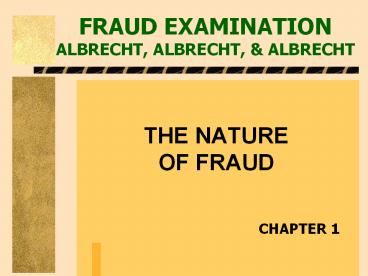FRAUD EXAMINATION ALBRECHT, ALBRECHT, - PowerPoint PPT Presentation
Title:
FRAUD EXAMINATION ALBRECHT, ALBRECHT,
Description:
Association of Certified Fraud Examiners. Employees taking employer's assets ... What Skills Are Needed to be a Fraud Fighter? Some Additional Skills that May ... – PowerPoint PPT presentation
Number of Views:177
Avg rating:3.0/5.0
Title: FRAUD EXAMINATION ALBRECHT, ALBRECHT,
1
FRAUD EXAMINATIONALBRECHT, ALBRECHT, ALBRECHT
- THE NATURE OF FRAUD
- CHAPTER 1
2
Learning Objectives
- Understand the seriousness of the fraud problem
and how it affects individuals, consumers and
organizations - Define fraud
- Classify fraud into various types
- Understand how expensive fraud is to a company,
investors, and a nation
3
Learning Objectives
- Distinguish between criminal and civil fraud laws
and how they relate to fraud. - Be familiar with types of fraud-fighting careers
today.
4
Describe the Seriousness of Fraud.
5
List Four Sources for Knowing How Much Fraud is
Occurring.
6
What are the Estimated Costs and Impacts of Fraud?
7
Explain How 1 in Fraud Represents 1 Lost
Profits.
8
What are the Seven Elements of Fraud?
9
What are the Seven Elements of Fraud?
10
Define FraudWhat it is and What it isnt.
- What it is
- What it isnt
11
Why Are We so Often Conned?
12
Classify Frauds and Give an Example of Each.
13
List Keys to Occupational Fraud and Define.
14
Complete this Chart.
Type of Fraud Victim Perpetrator Explanation
15
Differentiate between Direct and Indirect
Embezzlement.
16
What Are the Two Types of Vendor Fraud? Discuss.
17
Explain Customer Fraud.
18
Match Terms to Definitions.
Employee Embezzlement
Association of Certified Fraud Examiners
Employees taking employers assets
Management fraud
Overcharge for goods, or ship inferior goods
Investment scams
Selling worthless investments to unsuspecting
investors
Vendor fraud
Manipulation of financial statements by management
Customer fraud
Getting something for nothing, not paying for
goods services
ACFE
19
Differentiate between Criminal and Civil
Responses to Fraud.
Criminal Case Civil Case
Purpose
Consequences
Burden of Proof
Jury
Organization
Verdict
Claims
20
What Skills Are Needed to be a Fraud Fighter?
21
Some Additional Skills that May Prove Helpful
22
Employment Opportunities
Employer Types of Work
Government
CPA Firms, Forensic accounting firms, Law firms
Corporations
Organizations involved in civil cases
Universities, hospitals, etc.





























![Ecommerce Fraud Prevention: Types, Best Practices & Tools [2019] PowerPoint PPT Presentation](https://s3.amazonaws.com/images.powershow.com/9327447.th0.jpg?_=20190904075)

